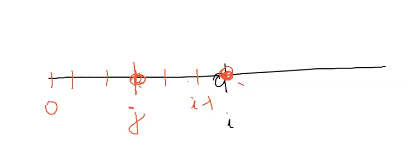DP 3
LIS ( Longest Increasing Subsequence)
We were looking at subarrays till last article. now its subsequence (its not supposed to contiguous instead it maintains order of appearance )
- for every $s_i$ : LIS ending at i
res = max{$s_i$}
- now how to find the $s_i$ <- Length of LIS ending at $i$
at any $j<i$ if $A[i]>A[j]$ we can extend the subsequence
- $ S_i = 1 + max_{j\le i} {S_j} $ and $A[i]>A[j]$
Checking DP
-
Prefix Array with dimension 1, size <- n
-
Base Case
dp[0] = 1
int lengthOfLIS(vector<int>& nums) {
int n = nums.size(),i,j, res = 1;
vector<int> dp(n,1);
for(i = 1; i < n; i++){
// compute dp[i]
for(j = i-1; j >= 0; j--)
if(nums[i] > nums[j])
dp[i] = max(dp[i],1+dp[j]);
res = max(res,dp[i]);
} return res; }
Longest Arithmetic Subsequence
$S_i$ <- length of the largest Arithmetic sequence ending at i.

common difference = $A[i] - A[j]$
for index $j$ we will store LAS (common difference$d$) ending at j
$j$ -> for every cd LAS ending at $j$
Extra Step…
Dimension -> 2D DP
Nature -> prefix arrays, common difference
Data Structure -> use unordered_map<int,int> : key -> cd , value -> length of longest chain.
int longestArithSeqLength(vector<int>& A) {
int n = A.size(), i, j, cd, res = 0;
vector<unordered_map < int, int >> dp(n);
for(i = 0; i< n; i++){
// compute dp[i]
for(j = 0; j < i; j++){
cd = A[i] - A[j];
if(dp[j].find(cd) == dp[j].end())
dp[i][cd] = 2;
else
dp[i][cd] = 1+dp[j][cd];
res = max(res,dp[i][cd]); }
} return res; }
Above gives TLE : one quick fix is the line after calculating cd , second way using a vector of 1000 size because its possible to get small common difference .
Maps were giving TLE because , maps are not always O(1) , instead its average case performance.
int longestArithSeqLength(vector<int>& A) {
int n = A.size(), i, j, cd, res = 0;
vector<vector<int>> dp(n, vector<int> (1001,0));
for(i = 0; i< n; i++){
// compute dp[i]
for(j = 0; j < i; j++){
cd = A[i] - A[j];
dp[i][cd+500] = max(2,1+dp[j][cd+500]);
res = max(res,dp[i][cd+500]);
}
} return res; }
Word Break
All possible splits can be a calculated and some are valid and some are invalid splits.
so we can have splits at 0 , 1, 2 , … n-1 giving $s_1, s_2, s_3, … s_{n-1}$
“catsanddog”
0123456789
we can do a split [1,4,7] or make [3,6,8] and more..
S : set of all possible splits.
-
Criteria for splitting, we can mark first split at 0 , 1, 2 , …
so s1 : split that has first split at 0 mark
these splits are mutually exclusive and exhaustive in nature
-
$s_1$ : <- A[1…n-1] such that they all are in dictionary
$s_2$ : <- A[2…n-1]
Suffix Strings.
-
We should have a split s.t. all words [0…i-1] for some s_i are in dictionary
ans = OR{w[0…i-1] $\in$ D && $S_i$}
S = $w_1|w_2| w_3| … $
D = {$w_1, w_2, w_1 w_2 $}
Is DP needed , 1D DP, suffix array n size
Order to fill.
for $j > i$
Yes !
bool wordBreak(string s, vector<string>& wordDict) {
unordered_set<string> dict(wordDict.begin(), wordDict.end());
int i, j, n = s.size();
vector<bool> dp(n+1,false);
dp[n] = true;
string temp = "";
for(i = n-1; i>=0 ; i--){
//compute s_i
temp = "";
for(j = i; j <n; j++){
temp+=s[j];
if(dict.find(temp) == dict.end())
continue;
dp[i] = dp[i] || dp[j+1];
if(dp[i])
break;
}
} return dp[0]; }
[Work-Break II] :